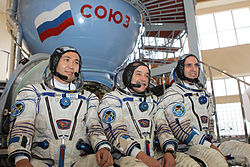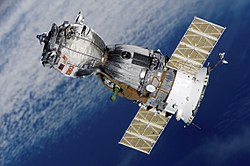 Soyuz TMA-11M docked at the ISS (center) | |
| Mission type | ISS crew transport |
|---|---|
| Operator | Roscosmos |
| COSPAR ID | 2013-061A |
| SATCAT no. | 39373 |
| Mission duration | 187 days, 21 hours, 44 minutes |
| Spacecraft properties | |
| Spacecraft | Soyuz 11F732A47 No.711 |
| Spacecraft type | Soyuz-TMA 11F747 |
| Manufacturer | Energia |
| Crew | |
| Crew size | 3 |
| Members | Mikhail V. Tyurin Richard A. Mastracchio Koichi Wakata |
| Callsign | Vostok |
| Start of mission | |
| Launch date | 7 November 2013, 04:14:15 UTC [1] |
| Rocket | Soyuz-FG |
| Launch site | Baikonur 1/5 |
| End of mission | |
| Landing date | 14 May 2014, 01:58 UTC |
| Orbital parameters | |
| Reference system | Geocentric |
| Regime | Low Earth |
| Docking with ISS | |
| Docking port | Rassvet nadir |
| Docking date | 7 November 2013, 10:27 UTC |
| Undocking date | 13 May 2014, 22:36 UTC |
| Time docked | 187 days, 12 hours, 9 minutes |
 (l-r) Wakata, Tyurin and Mastracchio Soyuz programme (Crewed missions) | |
Soyuz TMA-11M was a 2013 flight to the International Space Station. It transported three members of the Expedition 38 crew to the International Space Station. TMA-11M is the 120th flight of a Soyuz spacecraft, with the first flight launching in 1967. The successful docking of the Soyuz TMA-11M spacecraft on November 7, 2013 marked the first time since October 2009 that nine people have resided on the space station without the presence of a Space Shuttle.
Contents
The rocket and spacecraft carried Olympic symbols on the fairing of the ship. During the mission, the Olympic torch was passed for the first time in open space. Russian cosmonauts Oleg Kotov and Sergey Ryazansky passed it in the Russian section of the International Space Station.





